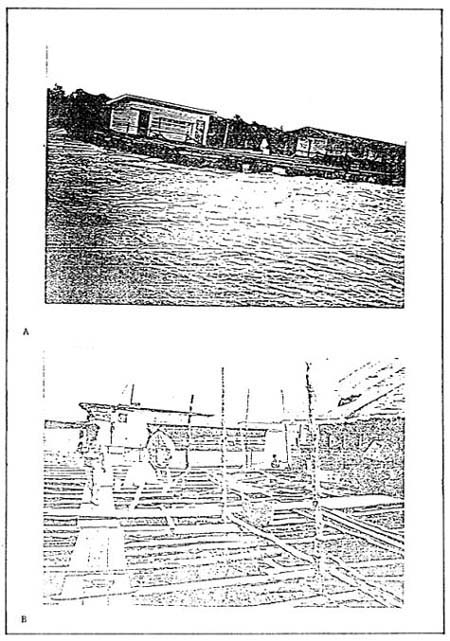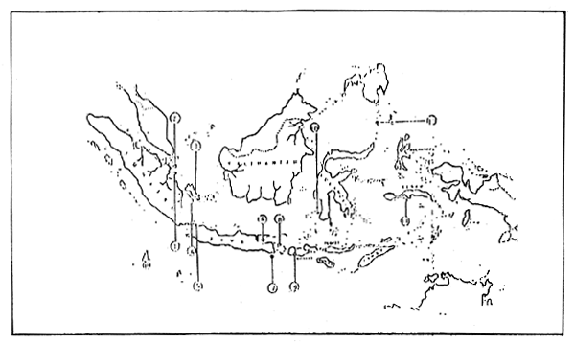Arbain Renvilee 1
I. Introduction
Riau Archipelago has 1,440 islands, and a potential area for marine fish culture of 249,017 km consisting of:
| - coastal waters | : | 239,805 km |
| - lands | : | 8,711 km |
These areas used to be a fertile grounds for natural stocks of fish,
seaweed and other marine organisms, able to sustain an important small
scale fishery activity. However, at present, these resources are
diminishing at a drastic rate as a result of heavy fishing. The declining
resources is affecting the livelihood of small-scale fishing families and
rural communities. This is causing serious socio-economic problems in the
coastal communities and, therefore, alternative solutions are required.
Netcage culture of coastal finfish has been pioneered by some people in
Riau Archipelago in 1982 and has expanded rapidly.
Such culture, is also supported by the Sub-marine Culture Research Agency
(Balai Penelitian Budidaya Pantai Tanjung Pinang) and the Department of
Fisheries of Riau Province through experimental activities.
1 Head, Fisheries Service of Batam, Belakang Padang, Riau Province, Indonesia.
II. Species of commercial importance
The following is a list of potential finfish species for netcage culture:
Grouper
Seabass (Lates calcarifer)
Siganidae (Rabbit fishes, Siganus sp.)
Carangidae (Caranx sp.)
The red grouper is the most popular species followed by the estuarine grouper.
Fry of grouper and other finfishes are only available from the wild. The grouper can be stocked intensively and grows to 600–800 g market weight in 6 – 8 months from initial weight of 50–200 g. The groupers represented 90% of total finfish production from seafarming activities.
III. Annual production statistics
Live fish production is mostly from fish capture and only partially from cultivation. The production in Riau Archipelago from 1983 to 1987 is listed below:
| Year | Production (MT) |
| 1983 | 0.75 |
| 1984 | 11.90 |
| 1985 | 11.25 |
| 1986 | 17.00 |
| 1987 | 12.00 |
The decrease recorded in 1987 is mainly due to the difficulty in collecting fry and their high price. Fry supply is limited and only caught from the wild.
IV. Culture method
The culture methods in Riau Archipelago are: (a) floating netcages and (b) stake netcages (Fig. 1).
In the floating system the netcages are fixed on a wooden frame kept afloat by means of plastic and oil drums. In the stake system the netcages are fixed on wooden and nibung stakes (fixed netcage).
Polyethylene netcage of various dimensions are used in the floating netcage system usually 5 × 5 × 3m, 3 × 3 × 3 (2.5)m, and 2.5 × 2.5 × 2.5m. In the stake netcage system they are usually 5 × 5 × 8m, 3 × 3 × 8m and 2.5 × 2.5 × 8m.
V. Feeding
Feeding in the form of chopped fresh trash fish is given to the cultured fish twice a day in the morning and the afternoon. The amount of feed given is about 8–10 % of the total biomass of the stocked fish. During the culture period of 6 months, the netcage is changed every month.
VI. Disease control
Prevention and control of disease is vital in producing high and stable yields of fish in netcages. To control disease, preventive measures are necessary through the maintenance of good water quality standard in accordance to culture requirement. It is important to minimise environmental stress arising from low level of dissolved oxygen and to avoid accumulation of metabolic waste and ammonia.

Figure 1. Floating netcages (A) and stake netcages (B).
VII. Oceanographic data/site selection criteria
In the West Coast of Riau Archipelago waves are not strong except in the west wind season (August, September and October) and north wind season (November, December and January). Strong winds and waves occur in the East Coast which faces the China Sea.
Water is sufficiently clear.
Water circulation rate is good.
Water quality. The site should be far from the sources of domestic, industrial and agricultural pollution and other environmental hazards.
Salinity in the coastal water is influenced by the Malacca Straits, generally about 29 – 32 ‰ such as in Karimum Island, Mori Island, Serrayang Island, Biritan Island and Batam Island. It differs from the coastal waters influenced by the South China Sea, like Natuna Islands, Anambas Islands and Tembelan Island, where average salinity is about 33 ‰.
VIII. Location of culture sites
The potential areas suitable for finfish culture in floating and stake netcages are in Bintan Island, Serrayang Island and Batam Island (Fig.2).
IX. Harvesting and handling methods
Fish are harvested from the netcage by pulling the net on one side of the frame unit and slowly concentrating the fish through marginally lifting the net panel over the edge of the frame. The fish are scooped into holding tanks in boats or ships.
X. Marketing
The production is mostly exported live to Singapore, while only a little part is for local consumption. Live fish is highly demanded.
XI. Constraints
Poor fry supply.
High fry unit price.
High feed costs.
Poor labour culture skill.
Limited suitable culture sites.

Figure 2. Potential areas for finfish culture in Batan Island, Riau Archipelago.